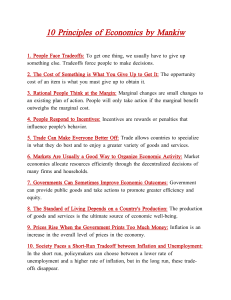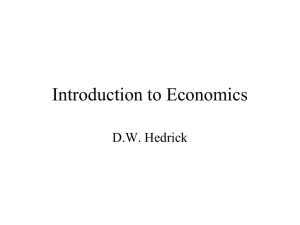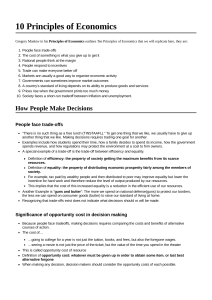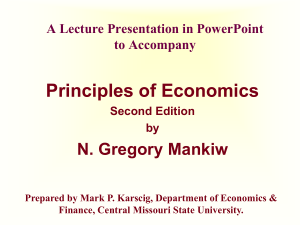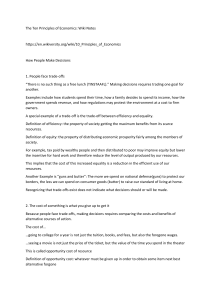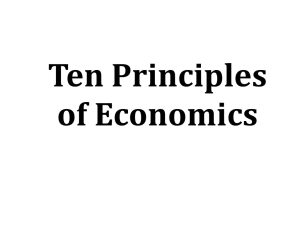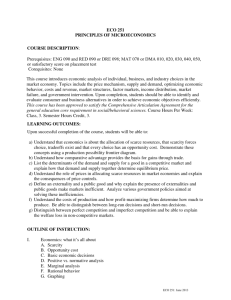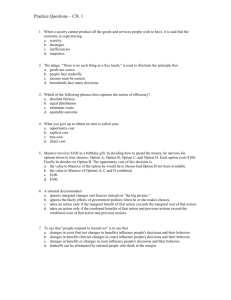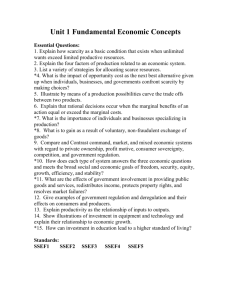Introdution to Economics (new)
advertisement
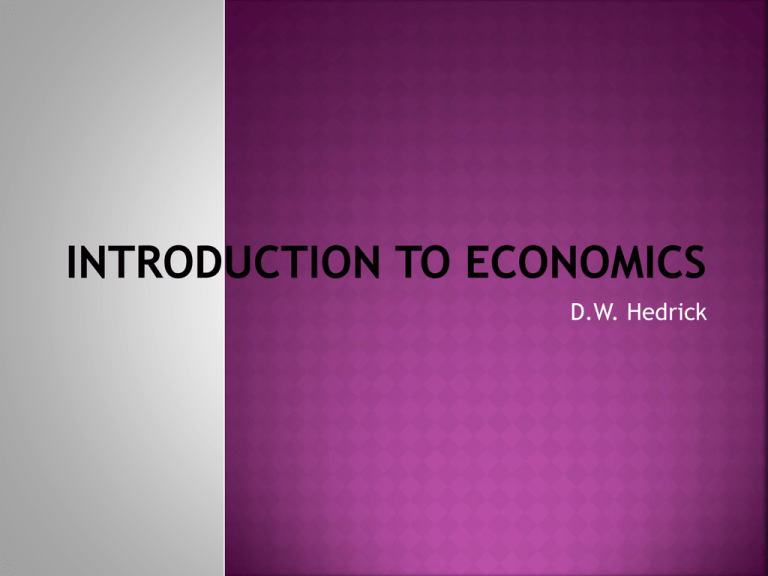
D.W. Hedrick Primarily Lecture format with discussion, simulations, and video presentations Constructive discussion is welcomed Grading is based on Aplia Homeworks (20%), five of seven quizzes (20%), three midterms (20% each), and an optional comprehensive final (replaces lowest midterm) – NO MAKEUPS GIVEN Suggestions for the study of economics Read the book before coming to class Recopy lectures and reread the book within several hours of class Identify what you don’t understand Ask questions in class Use the Aplia and the study guide (optional) Go to tutors in supplemental instruction (if offered) Visit the professor during office hours Mankiw’s How Society manages its scarce resources Hedrick’s definition definition How society chooses to allocate its scarce resources among competing demands to best satisfy human wants Alternative definitions Economics is the study of choice. Economics is what economist do. Wikipedia's perspective Scarcity : Unlimited wants versus limited resources Choices and tradeoffs Opportunity Costs All societies must answer the WHFM questions What is to be produced? How is to be produced? For whom will it be produced? The Scientific Method Observation →Hypothesis →Testing Observation: identifying and measuring important variables – orderly loss of information Paraphrasing Einstein, “ Everything should be made as simple as possible, but no simpler.” K. Boulding, “Knowledge is always gained by the orderly loss of information.” Assumptions and ceteris paribus Theories Models: realism or usefulness Hypothesis: educated guesses about cause and effect of the variables Testing: theories can’t be proven and are supported by repeated failed attempts to disprove them. Microeconomics vs. Macroeconomics The Assumption of Rational Behavior Max TNB = TB – TC Boxes Example MB=MC rule People respond to incentives Limits to the use of rational behavior (e.g. axe murders) Normative vs. positive approaches A brief history of economic thinking The language of economics How people make decisions? How people interact? How does the economy work overall? Principle #1 - People face tradeoffs Time allocation – an example of tradeoffs Production Possibilities Frontier Efficiency versus equity Principle #2 - The cost of something is what you have to give up to get it Opportunity costs come from Von Weiser, a German economist late 1800s Opportunity costs are independent of monetary units TINSTAAFL The real costs of going to college Principle #3 - Rational people think at the margin Rational or irrational decision-making Marginal benefits and costs versus total benefits and costs Weighing marginal costs and benefits leads to maximizing net benefits (total welfare) Principle #4 –People respond to incentives Reactions to changes in marginal benefits and costs Increases (decreases) in marginal benefits mean more (less) of an activity Increases (decreases) in marginal costs mean less (more) of an activity Example of seat belts leading to increased speeds Example of SUV (with child car seat) in Issaquah Principle #5 - Trade can make everybody Society better off Adam Smith author of the “An Inquiry into the Causes and Consequences of the Wealth of Nations” 1776 Gains from the division of labor and specialization Mercantilists perspectives Example of why Ellensburgians should trade with others Principle #6 - Markets are usually a good way of organizing economic activity Feudal times and haciendas in the new world The power of trade: cooperation versus conflict Markets: prices and quantities traded, typical and abstract Principle #6 - Markets are usually a good way of organizing economic activity creativity and productivity and resource allocation “Failure” of centrally planned economies “set it and forget it” becomes “compete or be obsolete” Principle #7 Governments can sometimes improve market outcomes Market signals can fail to allocate resources efficiently or equitably Public goods, the exclusion principle, the freerider problem and non-rival consumption External costs and benefits Examples: vaccines, education, pollution Principle #7 Governments can sometimes improve market outcomes Equitable or fair distribution of resources Efficiency and equity: the pie analogy Government Failure: is government intervention always the proper solution? Principle # 8 – A country’s standard of living depends upon its ability to produce goods and services Adam Smith’s “An Inquiry into the Nature and the Consequences of the Wealth of Nations” Materialism – more toys mean more welfare wealth: a necessary or sufficient condition for happiness (are rich people happier, children with lots of toys) Principle # 8 – A country’s standard of living depends upon its ability to produce goods and services leisure time and productivity the factors of production: land or natural resources, labor, capital, entrepreneurship technology and productivity the Rule of 72 and growth rates Principle #9 – The general level of prices rises when the government prints and distributes too much money Definition of money, and economic language Principle #9 – The general level of prices rises when the government prints and distributes too much money Examples: “Not worth a continental” and Argentina Establish of the Federal Reserve and the introduction of sustained inflation in the US Principle #10 – Society faces a short-run tradeoff between inflation and unemployment Short-run and the long-run Demand and supply shocks Short-run increases (decreases) in output above (below) long-run potential output lead to adjustments Principle #10 – Society faces a short-run tradeoff between inflation and unemployment Counter-cyclical stabilization versus pro-cyclical destabilization Political business cycles
